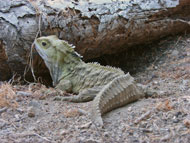Computer model of Sphenodon punctatus jaw confirms how it chews.
In the animal kingdom, it used to be thought that chewing was something that was essentially the domain of mammals, but now scientists from University College, London (UCL) and the University of Hull in the UK have discovered similar behavior in one of the oldest reptilian representatives on the planet. New Zealand’s tuatara (Sphenodon punctatus) which may look rather like a lizard, is actually a unique survivor from an older lineage of reptiles.
Benefits of Chewing and Slicing
Dr. Marc Jones, UCL Cell and Developmental Biology, explains: "Although the tuatara-like chewing mechanism is rare today, fossils from Europe and Mexico show us that during the time of the dinosaurs (about 160 million years ago) some fossil relatives of the tuatara used a similar system and it was much more widespread.
"Because mammals show the most sophisticated form of chewing, chewing has been linked to high metabolism. However, the tuatara chews food in a relatively complex way but its metabolism is no higher than that of other reptiles with simpler oral food processing abilities. Therefore the relationship between extensive food processing and high metabolism has perhaps been overstated."
Upper and lower jaws function separately, aiding the efficiency of the tuatara’s jaw movement. Dr. Jones said: "Some reptiles such as snakes are able to swallow their food whole but many others use repeated bites to break food down. The tuatara also slices up its food, much like a steak knife.
"The slicing jaws of the tuatara allow it to eat a wide range of prey including beetles, spiders, crickets, and small lizards. There are also several reports of sea birds being found decapitated following predation by tuatara."
New Investigative Tools
In order to understand the movement of the jaw to be seen in 3D, and from right around the skull, a computer model was used for this purpose. Dr. Neil Curtis from the University of Hull's Department of Engineering says: "We developed this virtual model using software that is widely used in the analysis of complex engineering systems. It is the most detailed musculoskeletal model of a skull ever developed and demonstrates the huge potential of this type of computer modeling in biology.
"It allows us to investigate movements within skulls that would be impossible to monitor in a live animal without using harmful X-rays which is not an option for protected species like the tuatara."
Reference: Marc Jones, Paul O'Higgins, Michael Fagan, Susan Evans & Neil Curtis. Shearing mechanics and the influence of a flexible symphysis during oral food processing in Sphenodon (Lepidosauria: Rhynchocephalia). The Anatomical Record, 29 May, 2012


